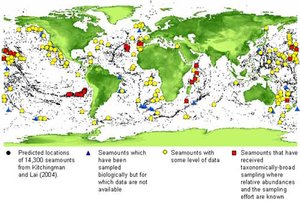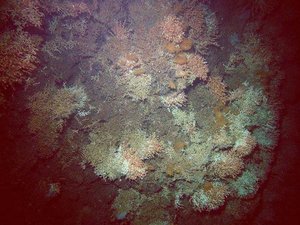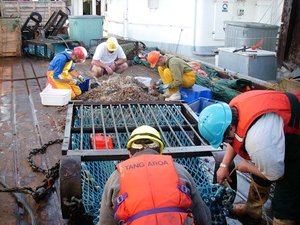Seamount
Contents
- 1 Introduction Seamounts are literally undersea mountains rising from the bottom of the sea that do not break the water's surface. Scientists generally define them as as steep geologic features rising from the seafloor with a minimum elevation of 1,000 meters (Seamount) and with a limited extent across the summit. This definition is not strictly adhered to, and steep undersea mountains are often referred to as seamounts, regardless of size.
- 2 Types of seamounts
- 3 Distribution and abundance of seamounts
- 4 Biological importance of seamounts
- 5 Conservation issues
- 6 Investigation of seamounts
- 7 Further reading
Introduction Seamounts are literally undersea mountains rising from the bottom of the sea that do not break the water's surface. Scientists generally define them as as steep geologic features rising from the seafloor with a minimum elevation of 1,000 meters (Seamount) and with a limited extent across the summit. This definition is not strictly adhered to, and steep undersea mountains are often referred to as seamounts, regardless of size.
 A multi-beam representation of a seamount called Sonne. (Source: CenSeam)
A multi-beam representation of a seamount called Sonne. (Source: CenSeam) Seamounts are usually isolated and cone-shaped, often volcanic in origin, and are usually composed of a hard substrate. A seamount tall enough to break the sea surface is called an oceanic island, e.g., the islands of Hawaii, the Azores and Bermuda were all underwater seamounts at some point in the past.
Seamounts are important and interesting for several reasons:
- They are excellent case studies for understanding marine biodiversity patterns. Seamounts vary greatly in their biodiversity, can have a high degree of endemism, may be centers of speciation, and may act as "stepping stones" for the dispersal of coastal species.
- They are areas of high production that support commercially important fisheries and coral mining.
- They are fragile ecosystems that must be managed carefully and with good scientific information in order to prevent habitat damage.
Types of seamounts
Three main types of submarine rise are formally recognized:
- Seamount – an isolated elevation rising 1000 meters (1km) or more from the seafloor and of limited extent across the summit
- Knoll – an isolated elevation rising less than 1000 m from the seafloor and of limited extent across the summit
- Pinnacle – a smaller pillar-like elevation off the seafloor.
Distribution and abundance of seamounts
 Seamount distribution map. (Source: CenSeam)
Seamount distribution map. (Source: CenSeam) Seamounts are found in all ocean basins of the world, with their distribution varying in both space and time. Seamounts are mostly volcanic in nature and therefore are found on oceanic crust, having being formed near mid-ocean spreading ridges, over upwelling plumes and in island-arc convergent settings. Nearly half of the world's seamounts are found in the Pacific Ocean. The rest are mostly found in the Atlantic and Indian Oceans, and overall there is a considerable bias towards the southern hemisphere.
There are estimated to be up to 100,000 seamounts over 1000m high, and thousands more if you count seamounts less than 1000m. These estimates are based on using satellite altimetry to examine gravitational anomalies in the sea surface – which can be related to undulations in the seafloor. However, the smallest and deepest seamounts cannot be well resolved and it is unlikely that we will ever know the true numbers of seamounts.
The online database SeamountsOnline estimates that less than 400 seamounts have been sampled, and of these less than 100 have been sampled in any detail. A key aim of marine scientists is to increase the number of seamounts that have been sampled, and to ensure that they are sampled in sufficient detail to enable meaningful conclusions to be drawn.
Biological importance of seamounts
Seamounts create complex current patterns that can influence sea life above them. Current-topography interactions on seamounts include semi-stationary eddies (Taylor columns), internal wave reflection, tidally induced currents and eddies, trapped waves, and eddies shed downstream. Currents up to forty-eight centimeters per second, or 0.9 knots, have been measured over seamounts. Due to these strong localized currents and upwellings, the plankton biomass is often high over seamounts and this combined with the constant influx of prey organisms, means that they can attract large numbers of fish. Thus, physical presence of seamounts has been shown to sometimes concentrate pelagic plankton and attract aggregations of fish, birds and mammals. As such seamounts are of economic as well as ecological value. Nearly 80 species are commercially harvested from seamounts including orange roughy, oreos, rockfish and alfonsino. Furthermore, seamounts are potential sites of seabed mining, e.g., cobalt.
Seamounts provide [[habitat]s] and spawning grounds for larger animals, including numerous fish. Some species including black oreo and black cardinalfish occur more often on seamounts than above the adjacent slopes and seafloor. Nearly 80 species of fish and shellfish are commercially harvested from seamounts and include rock lobster, mackerel, deep-sea red king crab, red snapper, several tuna species, orange roughy and perch. Some seamounts have been shown to support high levels of biodiversity and unique biological communities. In some instances high levels of endemic species (only found at that locality) have been found. Seamounts may act as regional centers of speciation, stepping stones for dispersal across the oceans and refugia for species with a shrinking range. Marine mammals, sharks, tuna, and cephalopods all congregate over seamounts to feed, and some seabirds have been shown to be more abundant in the vicinity of shallow seamounts.
Down on the seabed, volcanic rocks provide habitat for suspension feeders such as corals that capitalize on all the food that is swept around them in the strong currents. This is in sharp contrast to the typical deep-sea habitat where deposit-feeding animals rely on food that they eat on or in the sediment.
To date the most dominant organisms found on the hard substrates of seamounts are suspension feeders (animals that rely on water (Seawater) to deliver oxygen and food while removing waste and preventing burial by sediments), e.g., corals. Soft sediments also accumulate on seamounts and the dominant organisms occurring here are the polychaetes (a type of worm). Other animals that live in the sediments include oligochaetes (another type of worm) and gastropod mollusks (shelled animals).
Xenophyophores can be dominant in seamount sediments and have been found in the Pacific, Atlantic and Indian Oceans). They agglutinate particles including volcanic fragments, foraminifera (a type of single-celled animal) and glass chips to form a test which can be up to 25cm. These animals modify the environment providing a habitat for smaller animals as well as altering sediment deposition.
Conservation issues
Conservation issues relevant to seamounts revolve around endemism, harvest, and the low resilience of species:
- Endemism describes species that are native to or present at only one seamount. A survey in the southwest Pacific suggests that up to one-third of the species on seamounts can be endemics.
- Harvesting may also threaten species. There are well-documented cases of fishery exploitation, including the orange roughy off the coast of Australia and New Zealand and the pelagic armorhead at the northern Hawaiian ridge. Precious corals are highly valued for making jewelry and other decorative objects. Significant harvest has come from seamounts, and coral beds have frequently been depleted by overfishing. Other threats include mining, harvesting to develop potential medicines, and other seafloor disturbances.
- Species may have low resilience because they are long-lived, they have slow growth rates, they mature at old ages, they have low natural mortality, or their new recruits are only sporadic.
Investigation of seamounts
Studying seamounts poses significant technical challenges. While seamounts have been sampled since the 19th Century it is only in the last few decades that technologies have been developed to sample seamounts in sufficient detail. To date sampling is still biased towards the top 500 meters.
It is first necessary to map where the seamounts are. Satellite altimetry can be used to locate their position and general bathymetry. To obtain more detailed bathymetric information multi-beam acoustic mapping surveys are conducted. Multi-beam uses sound waves to produce detailed maps of the seafloor. Multi-beam can also be used to determine the composition of the seamounts, e.g., hard or soft sediments.
Camera surveys should be carried out where possible to provide a general overview of community structure. Cameras can be mounted on tows, in Remotely Operated Vehicles (ROVs), Autonomous Underwater Vehicles (AUVs), and Submersibles.
Further reading
- International Council for the Exploration of the Sea
- SeamountsOnline
- Sanctuary Integrated Monitoring Network
- Seamounts, deep-sea corals and fisheries - UNEP-WCMC Biodiversity Series 25
- CenSeam

